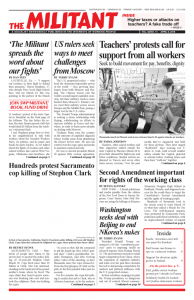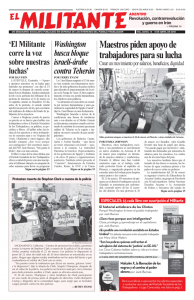Feigning concern for safety, Union Pacific bosses began using drones to spy on workers at 14 of its rail yards in December. A new crew of drone operators has been hired to look for “behaviors that deviate from the railroad’s rule books,” like workers “passing between railcars that are less than 100 feet apart” or “climbing off moving equipment,” the Wall Street Journal reported March 14.
But rail workers know that “safety” rules are designed to blame and victimize workers for train wrecks, on-the-job injuries and deaths. Those who work on the rails have often had supervisors tell them to “work safely” with a wink of the eye, and then tell them to get the work done fast. Some workers have already been written up on charges from drone surveillance.
Over the last several decades, rail bosses — in their drive for profits — have slashed crew sizes to the point where most freight trains run with a crew of just two, down from the four or five that was standard into the 1980s. Railroad owners are pushing to cut that to a one-person “crew,” but have met resistance by workers.
One-person operation has been a key factor in more than one recent train disaster, from the runaway train that derailed and exploded in Lac-Mégantic, Quebec, killing 47 people in 2013, to the Amtrak train that derailed and killed eight people near Philadelphia in 2015.
Rail bosses are not the only ones making fewer workers produce more, in less time. Corporate associations in both chicken and hog slaughter have asked the U.S. Department of Agriculture to allow them to jack up line speeds. A cooperative USDA has allowed 20 companies to speed up their lines to 175 birds a minute.
While squeezing more out per worker, the rail bosses have been skimping on rail and train maintenance, increasing the dangers. They keep increasing train lengths and run times. Some trains are now more than two miles long and fatigue is a growing challenge for workers.
Union Pacific says it suspended drone operations temporarily March 1, to try to get agreement from rail union officials. Meanwhile, it already has 126 operatives certified to fly the drones, using them to inspect bridges and flood damage as well as spying on yard crews. UP says it plans to double that number by the end of the year.
Officials of the Brotherhood of Locomotive Engineers and Trainmen, and SMART — the two main unions of operating craft rail workers — have challenged drone surveillance. BLET National President Dennis Pierce told Trains News Wire the spying “will reduce safety because the drones will distract crews.”
SMART General Chairperson Steve Simpson agreed, saying they would be a serious hazard.
An engineer in Boone, Iowa, who asked to remain anonymous, told the Militant he found out about the drones from co-workers. “Nobody I talked to approves,” he said. “They say if they see one they’ll stop working. They told me, ‘I don’t feel safe if I see a drone up there. How do I know who’s controlling it?’”

